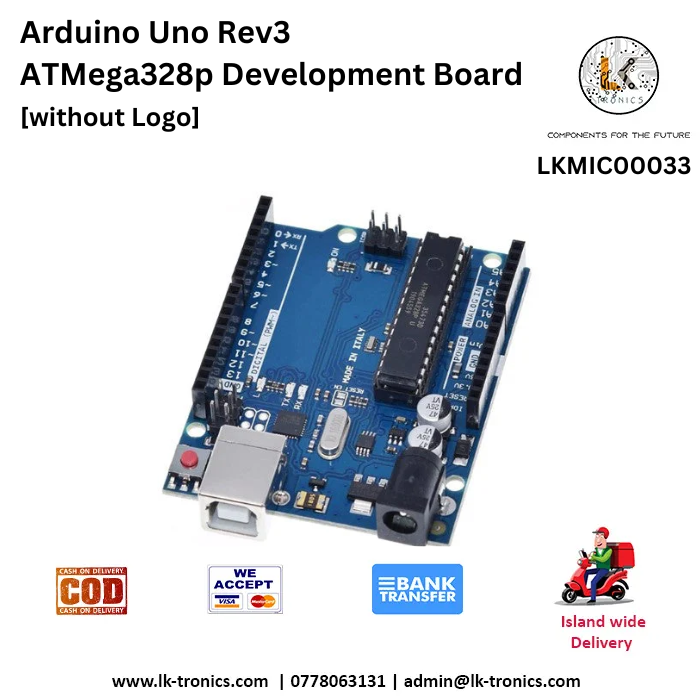Arduino Uno Rev3 ATMega328p Development Board [without Logo / without Cable]
In stock
LKMIC00033
Rs 2,000.00 Rs 3,500.00
In stock
CompareArduino Uno Rev3 ATMega328p Development Board [without Logo / without Cable]
ARDUINO UNO ATmega 328P
The 14 digital input/output pins in Arduino Uno ATmega 328P can used as input or output pins by using pinMode(), digitalRead(), and digital Write () functions in Arduino programming.
Each pin operates at 5V can provide or receive a maximum of 40mA current and has an internal pull-up resistor of 20-50 KOhms which are disconnected by default. Buy Arduino Uno ATmega 328P
How to use Arduino Board
Out of these 14 pins, some pins have specific functions as listed below, you can find the Pin Description in Arduino Uno
- Serial Pins 0 (Rx) and 1 (Tx): Rx and Tx pins are used to receive and transmit TTL serial data. They are connected with the corresponding ATmega328P USB to the TTL serial chip.
- External Interrupt Pins 2 and 3: These pins can be configured to trigger an interrupt on a low value, a rising or falling edge, or a change in value.
- PWM Pins 3, 5, 6, 9, and 11: These pins provide an 8-bit PWM output by using the analog Write() function.
- SPI Pins 10 (SS), 11 (MOSI), 12 (MISO), and 13 (SCK): These pins are used for SPI communication.
- In-built LED Pin 13: This pin is connected with a built-in LED, and pin 13 is HIGH–the LED is on and pin 13 is LOW, it’s off.
- Analog pin 4 (SDA) and pin 5 (SCA) are used for TWI communication using the Wire library.
Arduino Uno has a couple of other pins as explained below:
- AREF: Used to provide a reference voltage for analog inputs with analogReference() function.
- Reset Pin: Making this pin LOW, resets the microcontroller.
Pin Description in Arduino Uno ATmega 328P
Refer to the below table for the Pin Description in Arduino Uno. Any problems? direct message us
| Pin Category | Pin Name | Details |
| Power | Vin, 3.3V, 5V, GND | using an external power source.
5V: Regulated power supply used to power the microcontroller and other components on the board. 3.3V: 3.3V supply generated by on-board voltage regulator. Maximum current draw is 50mA. GND: ground pins. |
| Reset | Reset | Resets the microcontroller. |
| Analog Pins | A0 – A5 | Used to provide analog input in the range of 0-5V |
| Input/output Pins | Digital Pins 0 – 13 | Can be used as input or output pins. |
| Serial | 0(Rx), 1(Tx) | Used to receive and transmit TTL serial data. |
| External Interrupts | 2, 3 | To trigger an interrupt. |
| PWM | 3, 5, 6, 9, 11 | Provides 8-bit PWM output. |
| SPI | 10 (SS), 11 (MOSI), 12 (MISO) and 13 (SCK) | Used for SPI communication. |
| Inbuilt LED | 13 | To turn on the inbuilt LED. |
| TWI | A4 (SDA), and A5 (SCA) are | Used for TWI communication. |
| AREF | AREF | To provide a reference voltage for input voltage. |
Arduino Uno Technical Specifications
| Microcontroller | ATmega328P – 8-bit AVR family microcontroller |
| Operating Voltage | 5V |
| Recommended Input Voltage | 7-12V |
| Input Voltage Limits | 6-20V |
| Analog Input Pins | 6 (A0 – A5) |
| Digital I/O Pins | 14 (Out of which 6 provide PWM output) |
| DC Current on I/O Pins | 40 mA |
| DC Current on 3.3V Pin | 50 mA |
| Flash Memory | 32 KB (0.5 KB is used for the Bootloader) |
| SRAM | 2 KB |
| EEPROM | 1 KB |
| Frequency (Clock Speed) | 16 MHz |
Arduino Communication
A computer, an additional Arduino board, and other microcontrollers can all connect with Arduino. The ATmega328P microcontroller provides UART TTL (5V) serial communication which can do using digital pin 0 (Rx) and digital pin 1 (Tx). An ATmega16U2 on the board channels this serial communication over USB and appears as a virtual COM port to software on the computer. The ATmega16U2 firmware uses the standard USB COM drivers, and no external driver is needed. on Windows, a .inf file is required.
The Arduino software
The Arduino software includes a serial monitor that allows simple textual data to send to and from the Arduino board. There are two RX and TX LEDs on the Arduino board which will flash after data is being transmitted via the USB-to-serial chip and USB connection to the computer (not for serial communication on pins 0 and 1). A Software Serial library allows for serial communication on any of Uno’s digital pins. The ATmega328P supports I2C (TWI) and SPI communication. The Arduino software includes a Wire library to simplify the use of the I2C bus. Buy Arduino uno Sri Lanka to make your work easy.
ARDUINO UNO Pinout
The pin mapping between the Arduino Uno and ATmega328 chip
Software
Arduino IDE (Integrated Development Environment) requires programming the Arduino Uno board. Download it here.
Programming Arduino
Arduino IDE is installed on the computer, connect the board to the computer using a USB cable. Now open the Arduino IDE and choose the correct board by selecting>Tools>Boards>Arduino/Genuine Uno. choose the correct Port by selecting Tools>Port. Arduino Uno is a program using Arduino programming language based on Wiring. To get it to start with the Arduino Uno board and blink the built-in LED, load the example code by selecting Files>Examples>Basics>Blink. In this example code is loaded into your IDE, click on the ‘upload’ button given on the top bar. After the upload is finished, you should see the Arduino’s built-in LED blinking. Below is the example code for blinking:
//The setup function runs once when you press reset or power the board
void setup() {
// initialize digital pin LED_BUILTIN as an output.
pinMode(LED_BUILTIN, OUTPUT);
}
//The, loop function runs over and over again forever
void loop() {
digitalWrite(LED_BUILTIN, HIGH); // turn the LED on (HIGH is the voltage level)
delay(1000); // wait for a second
digitalWrite(LED_BUILTIN, LOW); // turn the LED off by making the voltage LOW
delay(1000); // wait for a second
}
Applications
- Prototyping of Electronics Products and Systems
- Multiple DIY Projects.
- Easy to use for beginner-level DIYers and makers.
- Projects requiring Multiple I/O interfaces and communications.
Based on 0 reviews
Be the first to review “Arduino Uno Rev3 ATMega328p Development Board [without Logo / without Cable]”
You must be logged in to post a review.


![Arduino Uno Rev3 ATMega328p Development Board [without Logo / without Cable]](https://i0.wp.com/lk-tronics.com/wp-content/uploads/2024/04/Pro-2-3.png?fit=700%2C700&ssl=1)
![Arduino Uno Rev3 ATMega328p Development Board [without Logo / without Cable] - Image 2](https://i0.wp.com/lk-tronics.com/wp-content/uploads/2024/04/Pro-1-3.png?fit=700%2C700&ssl=1)
![Arduino Uno Rev3 ATMega328p Development Board [without Logo / without Cable] - Image 3](https://i0.wp.com/lk-tronics.com/wp-content/uploads/2024/04/Pro-8.png?fit=700%2C700&ssl=1)









There are no reviews yet.